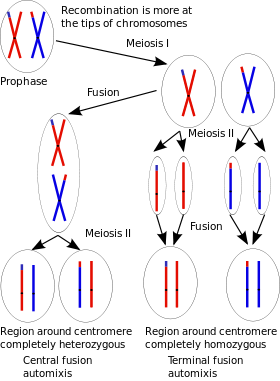We'll be back in a bit !
The system is currently undergoing a routine upgrade to ensure you get the best learning experience. The maintenance is expected to continue till 8:00 pm. Please check back later.
Thank you for your understanding!

Parthenogenesis is a type of asexual reproduction where an organism develops from an unfertilized egg. It is a natural phenomenon that occurs in various organisms, including plants, invertebrates, and some vertebrates. Parthenogenesis can be classified into three categories: natural, artificial, and induced. In this article, we will explore the different types of parthenogenesis, their examples, advantages, disadvantages, and significance.
Natural parthenogenesis is the type of parthenogenesis that occurs without any external intervention. It is a common phenomenon in many plant species, where unfertilized eggs develop into embryos that grow into adult plants. Natural parthenogenesis is also observed in some invertebrates, such as rotifers, aphids, and daphnia.
One example of natural parthenogenesis in plants is the reproduction of the Kalanchoe plant. This plant produces small plantlets on the edges of its leaves, which eventually fall off and grow into new plants. The plantlets develop from unfertilized eggs that undergo parthenogenesis.
One of the significant advantages of natural parthenogenesis is that it allows organisms to reproduce without a mate, which can be advantageous in isolated or harsh environments where mates may be scarce. On the other hand, natural parthenogenesis can lead to a lack of genetic diversity, which can increase the risk of extinction due to environmental changes.
Artificial parthenogenesis is a process of creating embryos from unfertilized eggs using physical or chemical treatments to stimulate cell division.
Techniques Used in Artificial Parthenogenesis
The most common techniques used in artificial parthenogenesis include:
Electrofusion - a process that involves the use of an electric field to fuse an egg with another cell to initiate cell division.
Chemical activation - a technique that uses chemicals to stimulate the egg to divide.
Mechanical activation - a technique that involves the use of physical force, such as pressure or vibration, to initiate cell division.
Induced parthenogenesis is a process where an unfertilized egg undergoes development into an embryo under specific environmental conditions or through external intervention. It occurs naturally but can be induced under specific environmental conditions or through external intervention. It is commonly observed in some fish and reptiles.
The advantages and disadvantages of induced parthenogenesis are similar to those of natural parthenogenesis. It allows organisms to reproduce without mates, which can be advantageous in isolated environments. However, it can also lead
However, induced parthenogenesis can lead to a lack of genetic diversity, which can increase the risk of extinction due to environmental changes.
Parthenogenesis is a crucial biological process that plays a significant role in the reproduction of various organisms. It is an essential mechanism for organisms that are isolated or live in harsh environments, where mates may be scarce. Parthenogenesis also allows for the creation of genetically identical offspring, which can be advantageous in certain situations, such as scientific research or animal cloning.
Honeybee reproduction involves the queen bee laying eggs, which are fertilized by sperm stored in her body from mating with drones. These fertilized eggs develop into female worker bees, while unfertilized eggs develop into male drones.
Honeybees' unique reproductive system involves the queen bee using stored sperm to fertilize some eggs and lay unfertilized eggs for the production of drones. The workers and drones are produced through different types of parthenogenesis. The workers are produced through thelytokous parthenogenesis, where the unfertilized egg develops into a female, genetically identical to the queen. The drones are produced through arrhenotokous parthenogenesis, where the unfertilized egg develops into a male.
Parthenogenesis is advantageous for honeybees, as it allows for the production of genetically identical offspring, which can help maintain a healthy and productive colony. However, it can also lead to a lack of genetic diversity, which can increase the risk of disease and environmental changes.
Parthenogenesis and sexual reproduction both play critical roles in honeybee reproduction. Sexual reproduction allows for genetic diversity and adaptation to environmental changes, while parthenogenesis allows for the production of genetically identical offspring, which can be advantageous in maintaining a productive and healthy colony.
In conclusion, parthenogenesis is a crucial biological process that occurs naturally in various organisms and can be induced artificially. It has both advantages and disadvantages, including the lack of genetic diversity and the ability to produce genetically identical offspring. Understanding the different types of parthenogenesis and their applications in science and medicine can help us better understand the mechanisms of reproduction and advance research in these areas.
Yes, parthenogenesis is a common mode of reproduction in plants, especially in crops such as citrus, bananas, and grapes.
Yes, parthenogenesis can lead to the emergence of new species with unique characteristics.
Apomixis is a type of parthenogenesis where the offspring are produced without the formation of gametes.
